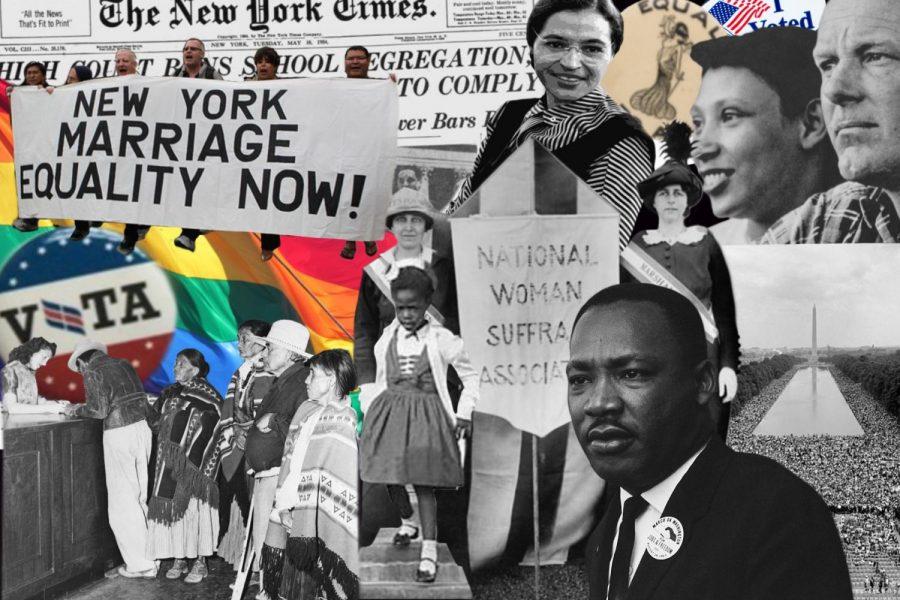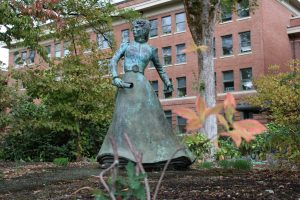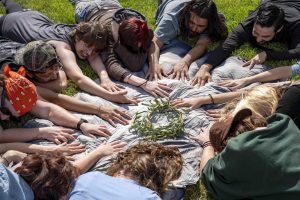Equality: Process, Progress and Preservation
November 12, 2020
The American Dream is a one of the prominent factors influencing the desire for equality in the United States.. The following timeline exhibits just a few of the monumental ways Americans have advocated for equality: by protesting for months, by questioning existing systems of inequality, by questioning the law itself, by forming organizations, and by fighting for rights together, in spite of whatever hurdles came their way.
1848: Seneca Falls Convention
The movement for women’s rights launched on a national level with the Seneca Falls Convention, organized by Elizabeth Cady Stanton and Lucretia Mott.
1865: 13th Amendment Outlaws Slavery
This amendment abolished slavery, though did not limit abuses of the criminal justice system against Black people. Laws such as the Jim Crow era limited the protection of minorities’ land, wealth and freedom whilst white people remained prioritized.
1866: Civil Rights Act Grants Citizenship to Native-Born Men, Excluded Indigenous People
This grant gave citizenship rights to all male persons born in the United States “without distinction of race or color, or previous condition of slavery or involuntary servitude.” This did not guarantee equal protection of laws to Black people, though, and despite what it says, excluded Indigenous people.
1868: 14th Amendment Grants Equal Protection of Laws to Black Americans
This amendment, ratified in 1868, granted citizenship to all persons born or naturalized in the United States—including former slaves—and guaranteed all citizens “equal protection of the laws.” The 14th amendment was one of three passed during the Reconstruction Era to establish civil and legal rights for Black Americans.
1870: 15th Amendment Establishes Right of Black Men to Vote
This amendment granted Black men the right to vote, though other discriminatory tactics were used to prevent them from using their right, especially in the South. It isn’t until the Voting Rights Act of 1965 that legal barriers denying Black men the right to vote were outlawed at the state and local levels under the 15th Amendment.
1872: Women Try to Vote
After casting her ballot, Susan B. Anthony was arrested, indicted, tried and convicted for attempting to vote in the presidential election. In the same year, Sojourner Truth, a former slave and civil rights advocate, was turned away after she demanded a ballot at a polling booth in Michigan.
1875: Civil Rights Act Grants Equal Treatment in Public Transportation, Accommodations and Service on Juries
This act prohibited racial discrimination in public places and facilities such as restaurants and buses. The law also made it a crime for anyone to deny these kinds of accommodations or services on the basis of colour, race or “previous condition of servitude.”
1882: Chinese Exclusion Act
This was the first and only major federal legislation to explicitly suspend immigration for a specific nationality. The law prohibited Chinese labourers from entering the country. Congress closed the gate to Chinese immigrants almost entirely by extending the act for another 10 years in 1902 and making the extension indefinite in 1904. The act was repealed in 1943 with the passage of the Magnuson Act, which permitted a quota of 105 Chinese immigrants annually.
1887: Dawes Act Passed
This granted citizenship to Indigenous people who gave up their tribal affiliations – meaning, if they assimilated, they could vote.
1890: Indian Naturalization Act
This granted citizenship to Indigenous people through an application process similar to that of naturalization – which seems even more disrespectful and frustrating when you consider the fact that Indigenous people were truly born here, had their land stolen from them and yet were still forced to apply for citizenship.
1896: Plessy v. Ferguson
The Supreme Court validated the principle of “separate but equal” in the U.S. – which essentially separated white and black people with the process of segregation.
1913: Massive National Suffrage Parade
In Washington D.C, a huge national suffrage parade is held, led by Inez Milholland Boissevain.
1919: American Indian Citizenship Act
This act granted U.S. citizenship only to Indigenous people who served in the military during World War 1.
1920: 19th Amendment Gives White Women the Right to Vote
This amendment granted white American women the right to vote. It did not eliminate state laws that kept Black Americans from the polls via poll taxes and literacy tests—nor did the 19th Amendment address violence or lynching. Only some African-American women will vote with the 19th Amendment.
1922: Supreme Court Rules People of Japanese Heritage Cannot Become Naturalized Citizens
Takao Ozawa v. the United States was a case in which the U.S. Supreme Court found Ozawa, a Japanese-American who was born in Japan but had lived in the United States for 20 years, ineligible for naturalization after trying to classify himself as ‘Caucasian’.
1923: People of Asian Indian Heritage Cannot Become Naturalized Citizens
In United States v. Bhagat Singh Thind, the Supreme Court ruled that Asian Indians cannot be naturalized, even after Thind tried to classify himself as ‘Caucasian’. Thus, like Ozawa did in 1922, Thind tried to claim he fell under the category of being white, instead of challenging the racist laws preventing their naturalization.
1924: The Society for Human Rights
The Society was founded by Henry Gerber in Chicago and was the first, and continues to be, the oldest gay rights organization in America.
1924: Indigenous People Granted Citizenship and Right to Vote
In this year, Indigenous people were granted citizenship and the right to vote. However, many states made laws and policies that denied Native Americans from voting.
1924: Immigration Act of 1924
With this act, immigration was open to people with a college education or special skills, but denied to Mexicans, and disproportionately to Eastern and Southern Europeans and Japanese. However, the legislation allowed for more immigration from Northern European nations like Britain, Ireland and Scandinavian countries.
1948: President Truman Ends Segregation in the U.S. Military
In an Executive Order, Truman abolished discrimination “on the basis of race, color, religion or national origin” in the U.S. Armed Forces.
1950: The Mattachine Society
This society, founded by gay rights activist Harry Hay, was another one of America’s first national gay rights organizations.
1952: McCarran-Walter Act Grants All People of Asian Heritage Right to Become Citizens
The act specifically removed previously established racial barriers that had acted to exclude immigrants from nations such as Japan and China, but still retained small quotas for those nations.
1954: Brown v. Board of Education
The U.S. Supreme Court ruled in the case Brown v. Board of Education of Topeka that racial segregation in public schools was unconstitutional. This overturned Plessy v. Ferguson of 1896, allowing Jim Crow laws to segregate public facilities for white and Black people. Thus, the Brown v. Board ruling implied segregation in all public facilities is prohibited.
1955: Daughters of Bilitis
This group became the first lesbian rights organization in the United States.
1955: Rosa Parks and the Montgomery Bus Boycott
Rosa Parks refused to give up her seat on a bus to a white man. This sparked the Montgomery Bus Boycott, which lasted 381 days. Eventually the Supreme Court ruled segregated seating as unconstitutional, going into effect in 1956.
1958: U.S. Supreme Court Rules in Favor of LGBTQ Rights for First Time
In One Inc. v. Olesen, the U.S. Supreme Court ruled in favor of the First Amendment rights of the lesbian, gay, bisexual and transgender magazine “One: The Homosexual Magazine.” The suit was filed after the U.S. Postal Service and FBI declared the magazine to be obscene material.
1961: 23rd Amendment Passed
Grants citizens of Washington, D.C. the right to vote for the U.S. president which they were prohibited from doing before, though even now, district residents – who are mostly Black people – do not have voting representation in Congress.
1963: March on Washington
Approximately 250,000 people gathered peacefully in Washington, D.C. to listen to speeches by civil rights leaders, including Martin Luther King, Jr.
1965: Civil Rights Act
Signed by President Johnson, this was a stronger version of previous Civil Rights Act, authorizing federal government to prevent racial discrimination in employment, voting and use of public facilities.
1973: Homosexuality Removed as Mental Illness
The board of the American Psychiatric Association finally voted to remove homosexuality from its list of mental illnesses in 1973.
1974: First Openly LGBTQ American Elected to Any Public Office
Kathy Kozachenko was the first openly gay cadidate elected to public office when she won a seat on the Ann Arbor, Michigan City Council.
1993: President Clinton Signs “Don’t Ask, Don’t Tell” Policy
This policy prohibited openly gay and lesbian Americans from serving in military and prohibits harassment of ‘closeted’ homosexuals.
2011: ‘Don’t Ask, Don’t Tell’ Repealed
The policy was repealed in 2011, meaning military service members and other Americans did not have to hide their sexuality anymore.
2015: Obergefell v. Hodges – Same-Sex Marriage Legalized
By one vote, the Supreme Court ruled that same-sex marriage cannot be banned in the United States and that all same-sex marriages must be recognized nationwide. This finally gave same-sex couples the equal rights heterosexual couples have under the law.
Every single fight for equality was momentous and revolutionary, a reminder that the true American Dream is individual, full of personal pain, loss and love–something we can only improve and obtain if we work together and continue to strive for a better future. The great strides made by American activists of the past provide a foundation for future generations to make further progress.
Sources available upon request.






